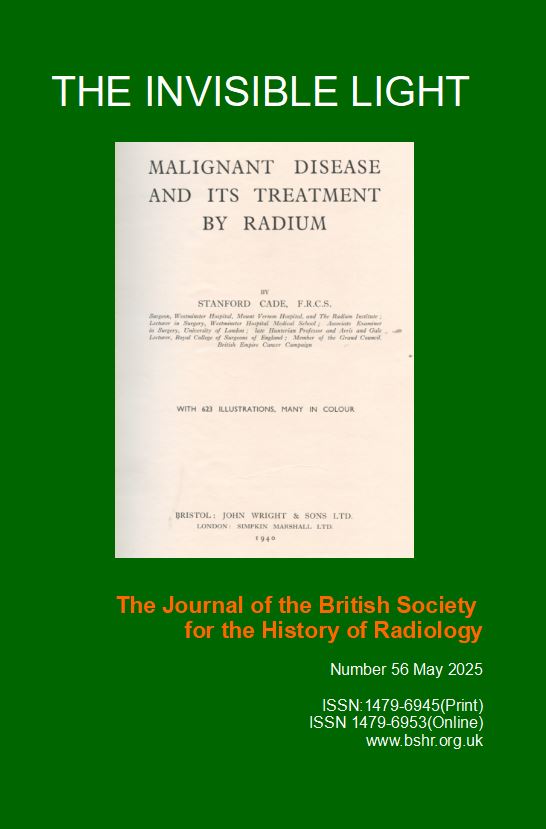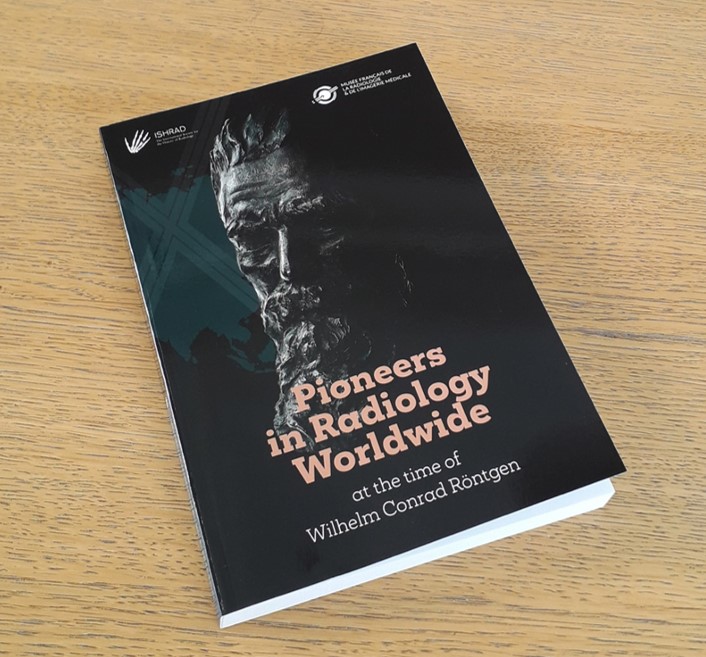... DEDICATED TO THE HISTORY OF RADIOLOGY IN ALL ITS FORMS...
| Try our history website of the month: The American Association of Physicists in Medicine. Click museum.aapm.org |
NEW FORMAT FOR INVISIBLE LIGHT
| We have changed the format of Invisible Light from Number 56 to a more bookcase-friendly 25x18 cm. |  |
| THE JOHN CLIFTON ESSAY PRIZE 2025 |
About the prize
The British Society for the History of Radiology is pleased to launch the John Clifton Essay Prize for 2025, promoting research and insight into the history of radiological sciences (including medical imaging, radiotherapy & nuclear medicine).
We are keen to receive essays that explore all aspects of radiology history including scientific discovery and technological development; biographical accounts; societal impact and cultural dimensions. Essays which explore less well-known events / figures, or which demonstrate the relevance of historical events to current and future practice are encouraged. Topics may include diagnostic imaging, interventional techniques, radiotherapy and may seek to highlight the work of radiologists, radiographers, physicists and engineers, or may explore imaging and therapeutic techniques from the patient’s perspective. Whilst entries are open to all, we particularly welcome participation from healthcare professionals in training and from undergraduates. Essays should be based on accurate historical research, but personal insights, reflections and perspectives can be included.
The prize is named in honour of Professor John Clifton (1930-2023), renowned medical physicist and member of BSHR over many years.
Competition details
Closing date: Friday 24th October 2025
Word limit: 5000 (excluding references)
Essays should be submitted in Word, using Times New Roman Font (size 12).
Please omit the author’s name from the Word document.
Essays should be fully referenced. If images are included, it should be possible to determine the copyright status to facilitate potential publication.
Entries must not have been previously published elsewhere.
Use of AI chatbot software or equivalent is prohibited.
Entries will be judged by members of the BSHR Council.
Entries should be sent to: This email address is being protected from spambots. You need JavaScript enabled to view it.
Prizes
First prize of £250 (and publication in Invisible Light / BSHR website)
Additional prizes may be awarded at the judges’ discretion.
Winners will also receive a year’s membership of BSHR.
All entries will be considered for publication in Invisible Light and on the BSHR website.
Winners will be announced at the BSHR Online lecture, 6th November 2025 (further details will be made available at bshr.org.uk)
| Other items on this page : |
Annual Lecture video |
Pioneers in Radiology Worldwide |
Other Features including past annual lectures |

A Personal History of Imaging in Radiotherapy
Prof Marcel van Herk
Click for here for the video of the 2025 Annual Lecture
| ONLINE LECTURE VIDEO |
The video of the BSHR online lecture 2024 "CT: Past, Present and Future" given on the 14th November by Dr Cynthia McCollough is now available here
| PIONEERS IN RADIOLOGY WORLDWIDE |

Some members of BSHR have contributed to a new book published and co- edited by ISHRAD (Int Soc Hist Radiology) with the SFR (French Society of Radiology). It contains 195 biographies of early radiology pioneers from 38 countries and is illustrated in colour. 250 pages.
The book 'Pioneers in Radiology Worldwide at the time of Rontgen' can be purchased from websites below.
https://eboutique.radiologie.f
https://www.livres-medicaux.c
| OTHER FEATURES |
See Arpan Banerjee' article about Roentgen published in radmagazine in November 2023 to celebrate the
world day of radiology. Check here.
Annual Lecture 2024
Signs and Symbols: Heraldry from Roentgen to The Present Day
Stephen Keevil
OnLine Lecture 2023
The Mummy Returns
Dr Ash Chakraborty
.
